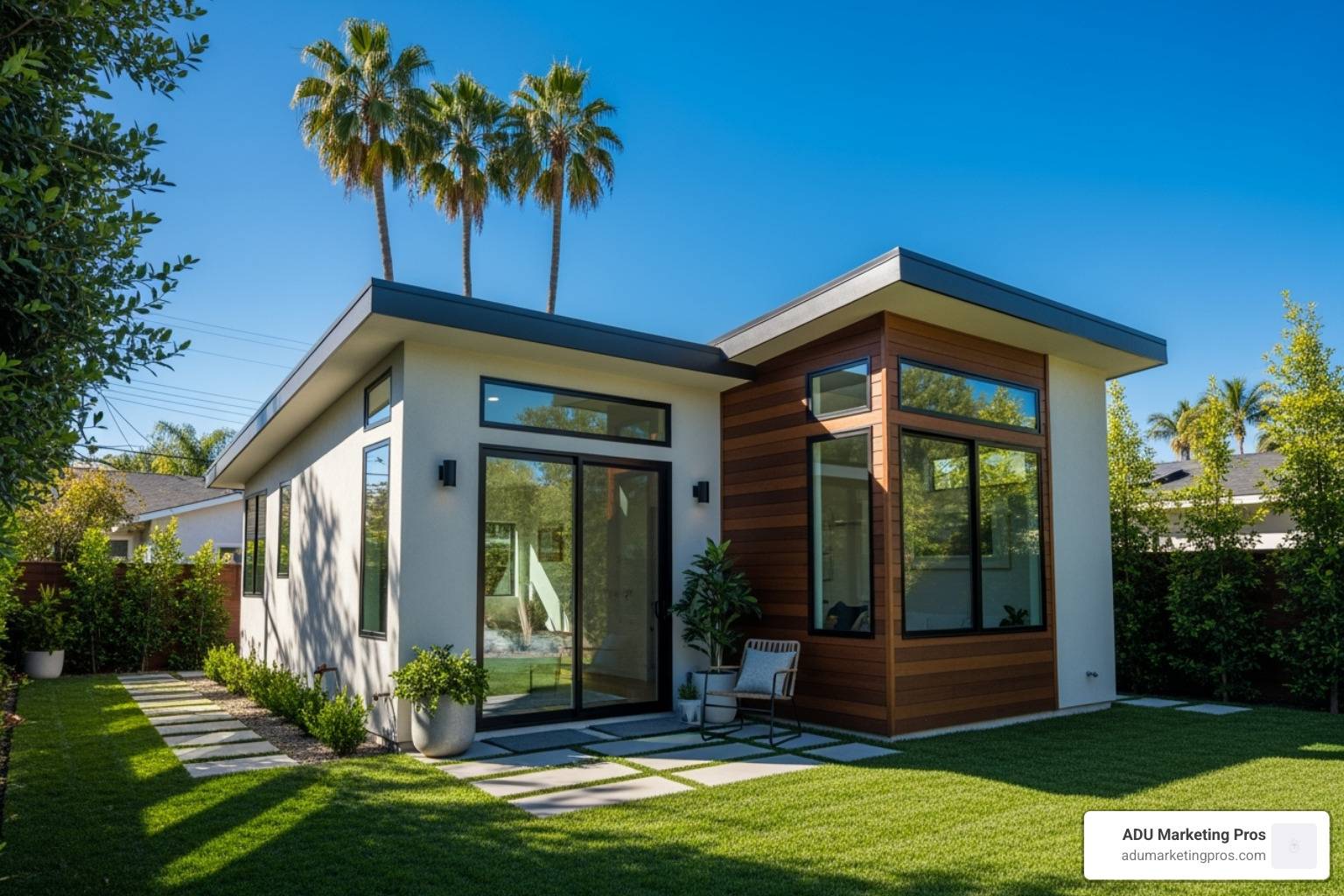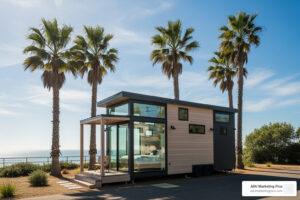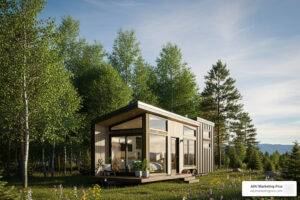Why Southern California ADU Projects Are Changing Backyards Across the Region
Southern California ADU construction has surged in recent years, driven by new state laws, high housing costs, and the flexibility these units offer. Whether you’re looking to generate rental income, house family, or add property value, an accessory dwelling unit (ADU) is a smart investment—but only with the right builder.
Quick Answer: What You Need to Know About Southern California ADU Builders
- Full-Service Design-Build Firms handle everything from permits to keys (best for hands-off homeowners)
- Prefab ADU Manufacturers offer faster timelines (as little as 8 weeks on-site) and fixed pricing
- General Contractors work from your architect’s plans and require more oversight
- Average Costs range from $150,000 to $400,000+ depending on size, finishes, and site conditions
- Key Requirements: Up to 1,200 sq. ft., 4-foot setbacks, ministerial approval within 60 days
The housing crisis has made ADUs a practical solution to Southern California’s skyrocketing rents and limited housing supply. ADU permits have surged as the state now counts them toward Regional Housing Needs Allocation (RHNA) targets.
However, building an ADU involves navigating state laws like AB 68, local zoning rules, and a wide array of builders. The wrong choice can lead to delays and cost overruns. This guide breaks down your options for ADU builders in Southern California, comparing construction methods, regulations, and costs to help you make an informed decision.

The ADU Advantage: Why Build in Southern California?
For thousands of Southern California homeowners, an ADU is a reality that provides financial stability and keeps families close. A Southern California ADU is more than extra square footage; it’s a financial tool, a family solution, and a flexible space that adapts to your life’s needs. Whether for a home office, rental income, or a haven for loved ones, an ADU transforms your property into a multi-functional asset.

The Financial and Familial Benefits
The rental income potential from a Southern California ADU is significant. With average rents between $1,800 and $3,500 per month, an ADU can generate serious passive income, with some homeowners recouping their investment in just five to seven years. Beyond rent, an ADU immediately boosts your home equity. Appraisers find that properties with ADUs command higher sale prices—often $150,000 to $250,000 more than comparable homes.
Many homeowners find the real value is keeping family close. Aging parents can live independently in a private space while you remain steps away. Adult children can save for their own home in an affordable space without moving back into their childhood bedroom. This arrangement provides privacy and autonomy for them and peace of mind for you. For a deeper dive into the numbers, check out more info about ADU building costs.
Contributing to the Housing Solution
Building an ADU makes you part of a larger solution to Southern California’s housing crisis. Every ADU adds a home to the regional supply, helping teachers, nurses, and young families afford to live in the communities they serve. ADUs work with existing neighborhoods by using in-place infrastructure like roads and utilities. This gentle density approach has a lower environmental impact and development cost than new housing tracts.
State and regional agencies like the Southern California Association of Governments (SCAG) now count ADUs toward Regional Housing Needs Allocation (RHNA) goals. By building an ADU, you contribute to a more sustainable and affordable housing future for the region without the disruption of large-scale development. To understand the laws that enable this, see a guide to California ADU regulations.
Navigating Key Southern California ADU Regulations
Building a Southern California ADU requires following rules that have become much more builder-friendly. Understanding state and local regulations is key to a smooth project and protecting your investment. California has worked to make ADU construction more accessible as a tool against the housing crisis, but compliance remains crucial for a safe and legal build.
Statewide Laws Simplifying ADU Construction
Recent California laws have removed major barriers to ADU development. If you’ve heard horror stories about permitting, the process is now dramatically different.
- AB 68 and AB 881 (2020): These laws were game-changers. They eliminated minimum lot size requirements and established a 60-day timeline for ministerial approval. This means if your plans meet objective standards, the local government must approve them without subjective reviews or discretionary denials.
- SB 13 (2020): This law further streamlined the process by suspending owner-occupancy requirements until January 1, 2025, offering flexibility to investors and homeowners. It also waived impact fees for ADUs under 750 square feet, making smaller units more affordable.
Additionally, the California Department of Housing and Community Development (HCD) now has enforcement authority to ensure local jurisdictions comply with state law. For a complete overview, consult the official HCD ADU Handbook and get more Details on the ADU Permit Process.
Key Development Standards to Know
These practical standards determine what you can build on your property.
- Size: State law allows ADUs up to 1,200 square feet. Critically, local agencies must permit ADUs of at least 800 square feet, regardless of other local zoning rules.
- Setbacks: Side and rear setbacks have been reduced to just 4 feet in most cases. This simple change opened up thousands of smaller properties for ADU development.
- Parking: Requirements are now waived if the property is within a half-mile of public transit, you are converting a garage, or a car-sharing program is nearby.
While state laws set the baseline, local jurisdictions add their own rules. For example, Los Angeles permits Movable Tiny Houses as ADUs, while San Diego has adjusted its rules on multiple ADUs per lot. San Bernardino County recently updated its code to align with new state laws. Always check your local city or county regulations before finalizing a design. For city-specific guidance, explore A look at Los Angeles ADU Regulations and San Diego ADU Laws explained.
Decoding the Cost to Build an ADU
“How much does an ADU really cost?” is the most common question we hear. A Southern California ADU is a major investment, and costs vary widely based on size, type, location, and finishes. A simple garage conversion might cost $50,000, while a high-end detached unit can exceed $400,000. Most homeowners building a detached ADU between 600 and 1,200 square feet should budget between $150,000 and $400,000.
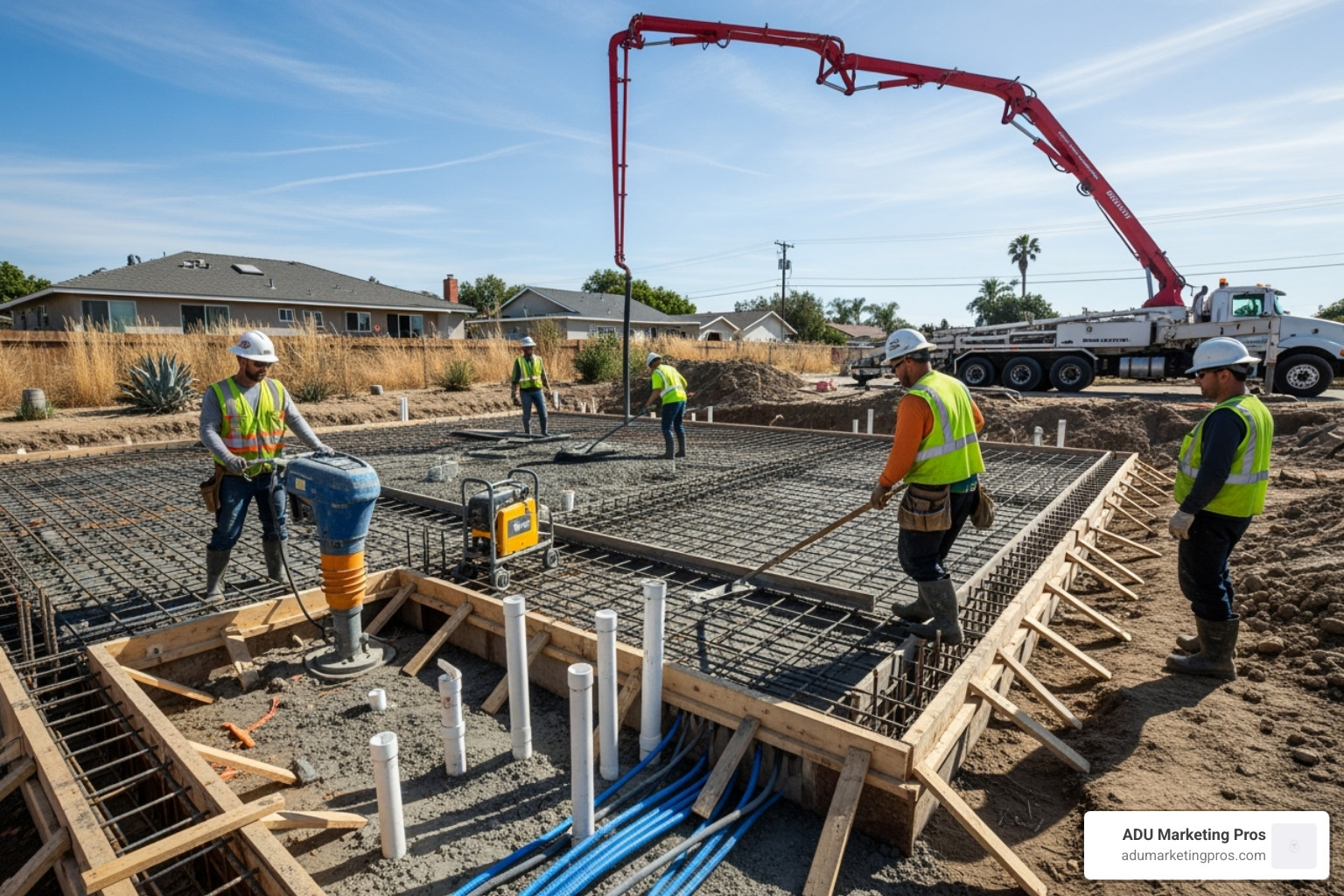
The final number depends on your site, design, and finish level. To get a personalized estimate, Use our ADU Cost Calculator. For more details on what drives these costs, see More info about ADU Building Costs.
A Complete Breakdown of ADU Costs
Here’s where the money goes:
- Permits and Fees ($5,000 – $25,000): This covers plan checks, building permits, and impact fees. SB 13 waives impact fees for ADUs under 750 sq. ft., which can save you thousands.
- Site Preparation ($5,000 – $50,000): Costs are lower for flat, accessible lots. Sloped properties, poor soil, or limited access for equipment will increase excavation and foundation expenses.
- Utility Connections ($10,000 – $30,000): This includes connecting water, sewer, and electricity. Costs rise if you need to upgrade your main panel or extend lines far from the main house.
- Construction and Labor ($80,000 – $250,000+): This is the largest expense, covering skilled labor like framers, electricians, and plumbers in Southern California’s competitive market. Complex designs cost more to build than simple, rectangular floor plans.
- Interior Finishes and Appliances ($20,000 – $80,000): This is where your style choices affect the budget. Basic finishes keep costs down, while custom cabinetry, high-end appliances, and designer lighting increase them.
Financing Your Southern California ADU Project
Several solid financing options are available for your Southern California ADU project.
- Home Equity Loans and HELOCs: Borrow against your home’s equity at relatively low interest rates.
- Cash-Out Refinancing: Refinance your mortgage for a larger amount and use the difference to fund the ADU, which is ideal if you can secure a lower interest rate.
- Construction and Renovation Loans: These short-term loans release funds in stages as work is completed and are designed specifically for building projects.
Excitingly, the CalHFA ADU Grant Program offers up to $40,000 to qualified homeowners for pre-construction costs like planning and permits. This is a grant, not a loan. The program has reopened with additional funding, but these funds go quickly, so check your eligibility soon. For a full overview of your options, Explore ADU Financing Options. The Casita Coalition’s ADU Finance Guide is another excellent resource.
Prefab vs. Site-Built: Choosing Your Construction Method
One of the biggest decisions for your Southern California ADU is choosing between a prefabricated unit and a traditional site-built home. Prefab is like assembling a pre-designed kit, while site-built is a fully custom creation. The right choice depends on your priorities for speed, cost, and customization.
Here’s a quick comparison:
| Feature | Prefabricated ADU | Traditional Site-Built ADU |
|---|---|---|
| Timeline | Faster (factory build + quick on-site install) | Slower (entirely built on-site) |
| Cost | Often more cost-effective (economies of scale) | Can be higher due to on-site labor and potential delays |
| Customization | More limited (standardized plans) | High (designed from scratch) |
| On-site Disruption | Minimal (most work done off-site) | Significant (long construction period in your backyard) |
| Quality Control | High (factory environment, consistent inspection) | Varies (site conditions, individual crew skill) |
The Prefab ADU Process
Prefab ADUs are built in a controlled factory while your foundation is prepared, then transported to your property for installation. The primary benefits are speed, cost-effectiveness, and minimal site disruption.
A prefab project can be completed in as little as 8-12 weeks, compared to 6-12 months for a traditional build. Costs are often lower due to bulk material purchasing and efficient factory processes. With most of the work done off-site, the construction chaos in your backyard is reduced to just a few days or weeks.
The main trade-offs are design limitations and transportation logistics. You’ll choose from a catalog of plans with some customization, rather than a fully custom design. Your property must also have clear access for large trucks and a crane.
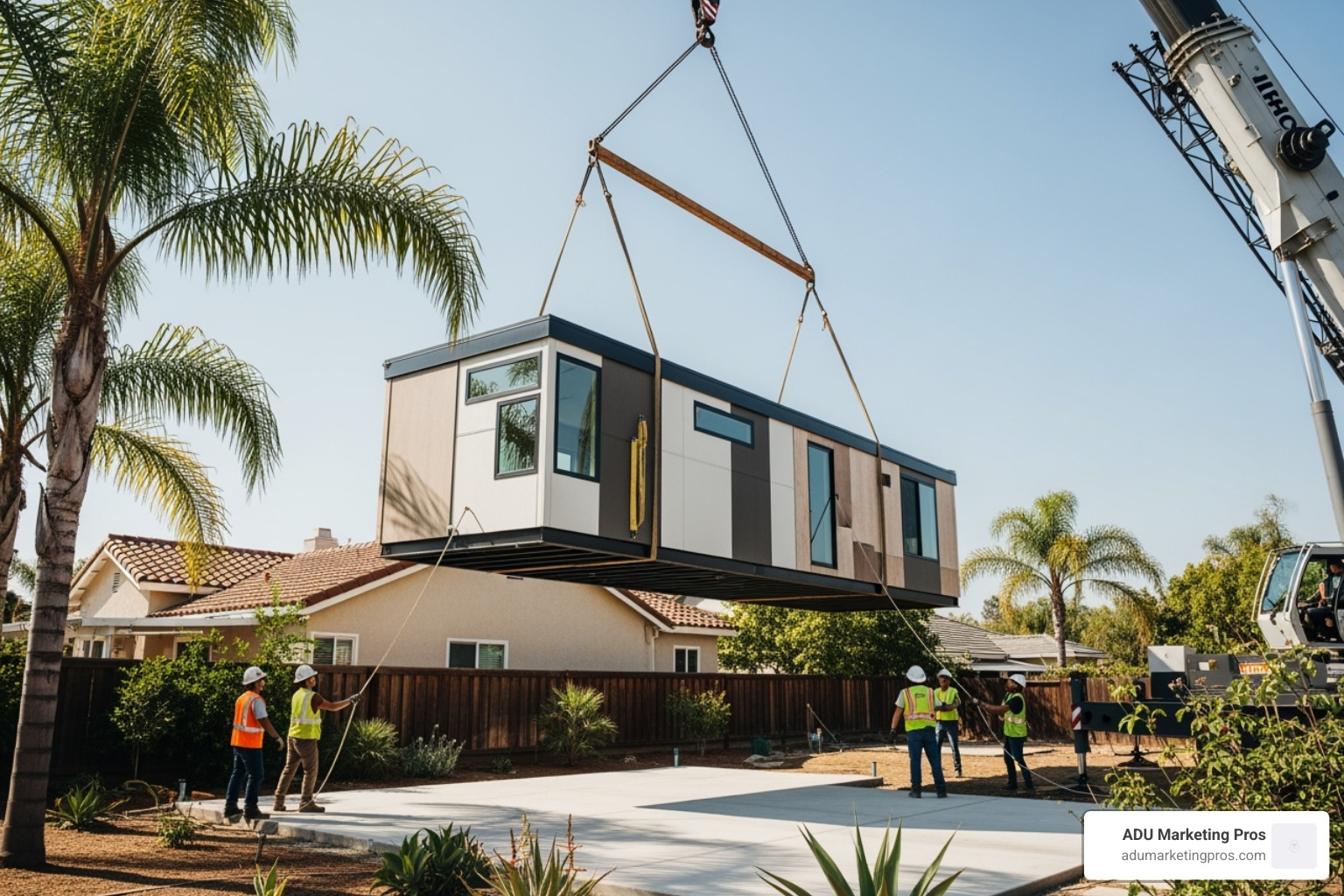
Types of Prefab ADUs in Southern California
The prefab market offers several options for your Southern California ADU:
- Modular ADUs: These are the most common type, built in sections in a factory to the same local building codes as site-built homes. They are assembled on a permanent foundation and often arrive with finishes and appliances installed.
- Panelized Kits: These kits include pre-cut walls, roof trusses, and floor systems that are assembled on your property. This offers more design flexibility than modular while retaining some factory efficiency.
- Manufactured Homes: Built to federal HUD code instead of local codes, these can be an affordable option, but not all jurisdictions permit them as ADUs.
- Tiny Homes on Foundation (THOFs): These smaller units (typically under 400 sq. ft.) are built to ANSI code. Some cities, like Los Angeles and San Diego, have ordinances allowing them as permitted ADUs, making them a quick and affordable choice. If this interests you, Find Tiny House Builders in Southern California.
How to Select the Right Southern California ADU Builder
Choosing the right builder for your Southern California ADU is the most critical decision you’ll make. It’s the difference between a smooth, on-budget project and a costly nightmare. Taking time to vet your options is an investment in your project’s success.
When interviewing builders, ask these key questions:
- Are you licensed and insured in California? (Always verify this yourself.)
- How many ADUs have you built in my city/county?
- Can you provide references and show me completed projects?
- What is your typical timeline and communication process?
- What is included in your pricing, and is it a fixed-price contract?
- How do you handle change orders and unexpected issues?
- What warranty do you offer on your work?
For a list of professionals to start your search, explore Find qualified Southern California ADU Builders.
Types of ADU Building Professionals
- Full-Service Design-Build Firms: A one-stop-shop managing everything from design and permits to construction. Ideal for homeowners who want a single point of contact and a hands-off process.
- Prefab ADU Manufacturers: They build the unit in a factory, but you’ll need a local contractor for site prep, foundation, and installation. This can be fast and cost-effective but requires coordination.
- General Contractors: They manage on-site construction based on plans you provide. This route offers design control but requires you to manage the architect and permitting process. For custom designs, consider finding Architects in Southern California Who Design Tiny Houses.
Key Considerations When Choosing Your Builder
- Licensing and Insurance: This is non-negotiable. Verify their California contractor’s license and ensure they have liability and worker’s compensation insurance.
- Local Experience: A builder familiar with your local jurisdiction’s permitting office and inspectors can prevent costly delays.
- Portfolio and References: Review their past work to ensure it matches your quality standards. Speaking with past clients provides invaluable insight into their reliability.
- Communication Style: A good builder communicates proactively and responds promptly. Poor communication early on is a major red flag.
- Contract Clarity: Your contract should detail the scope of work, payment schedule, timeline, and materials. Avoid vague language.
- Pricing Structure: Understand if you’re getting a fixed-price, cost-plus, or time-and-materials contract. Fixed-price offers the most budget certainty.
- Warranty: A reputable builder will warranty their workmanship for at least a year.
Conclusion
Building a Southern California ADU is a powerful investment in your future, family, and community. From generating rental income to housing loved ones, the advantages are clear. New state laws have made the process more accessible than ever, but navigating regulations, budgets from $150,000 to $400,000+, and construction methods remains complex.
While the opportunity is real, so are the challenges. Your choice of builder will make or break your experience. A great partner guides you through the process with clear communication and expertise, delivering a quality ADU on time and on budget. A poor choice can turn your dream into a disaster.
Take the time to vet your builder thoroughly—check licenses, speak to references, and demand a clear contract. Whether you opt for a full-service design-build firm, a prefab manufacturer, or a general contractor, ensure they have proven experience in the Southern California ADU market. The right partner is the foundation of a successful project.
For construction firms and architects in this space, connecting with informed homeowners requires a strong online presence that builds trust. At ADU Marketing Pros, we specialize in helping ADU businesses stand out in a crowded market. If you’re ready to grow your business and connect with serious clients, we invite you to learn how to grow your ADU business with expert educational content.
Your Southern California ADU journey starts with knowledge and succeeds with the right team. Here’s to building something great.

